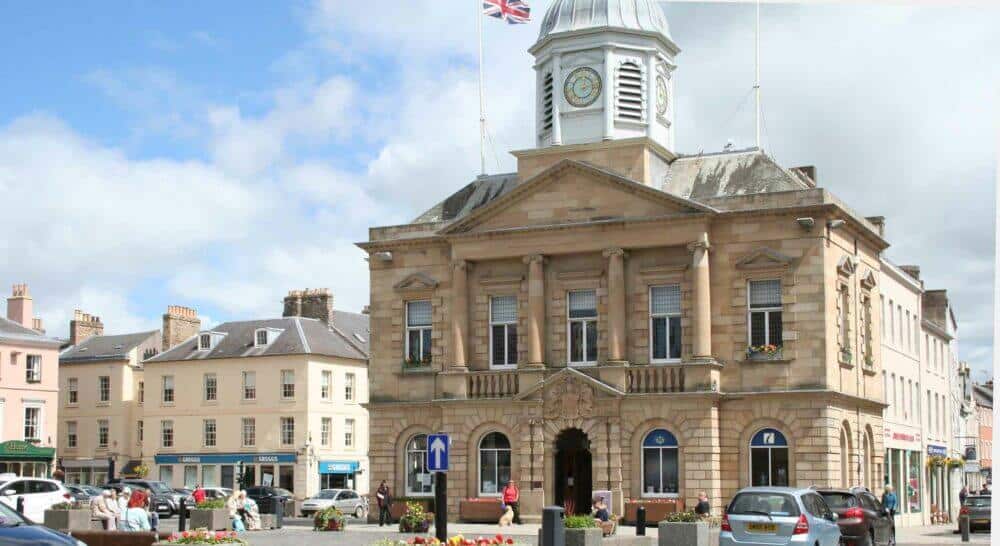
Kelso, a small Scottish Borders, town lies at the junction of the Rivers Tweed and Teviot.
The history of Kelso, Scotland
Over the centuries Romans, Border Reivers, Napoleonic prisoners of war and many others played their part in the wider historical narrative.
While Kelso’s history was often bloody and politically divisive it was never dull.
While acknowledging the role of others, Kelso’s history is more intimately connected to its Benedictine abbey, the now long gone royal burgh of Roxburgh and its castle.
Perhaps most importantly King David I, who brought some stability to his country after years of internal conflict.
Professor Geoffrey Barrow, in his assessment of David’s work, said…
“In southern Scotland, David quickly showed what was to prove the overriding passion of his life, reform of ecclesiastical institutions and revival of religion.”
Geoffrey Barrow
Kelso Liber, a collection of documents and charters
Many of the medieval documents relating to David’s southern centre of power are scattered in difficult to access collections around Europe.
However one compilation, the Liber S. Marie de Calchou (1846), better known today as the Kelso Liber, a collection of over 500 documents or charters, covering the period, 1113-1567.
It was the monks of Kelso Abbey who wrote this remarkable account, one of Scotland’ earliest chronicles.
Later, it was bound together for presentation to the Bannatyne Club, a select Edinburgh bibliographical society established by Sir Walter Scott in 1823.
Although the papers are written in Latin many of them have since been translated and interpreted by distinguished scholars and are today an absorbing and invaluable source of information.
The historian Cosmo Innes said in the English preface of the Kelso Liber, “No other spot of Scotch ground has witnessed such changes as the river bank where the Teviot falls into Tweed.
“A town once stood there, of such importance as to form one of the remarkable Burgher Parliament, known as the Court of the Four Burghs of Scotland.”
The year 1113, marks the point when, in the years before David became king, he brought a number of French Benedictine monks from Tiron near Chartres to Selkirk. They were the first of any of the reformed religions to come to Britain.
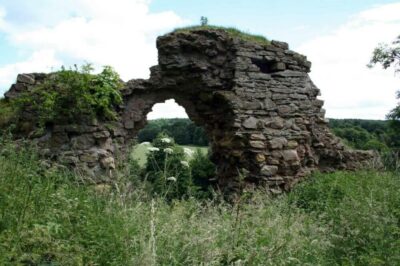
The monks were encouraged to live a simple life, they were according to one observer, required to practice, “whatever mechanical art they knew, both to preserve them from the corrupting power of idleness and to provide, by useful industry, for the maintenance of the community.”
In 1128, the Selkirk brethren were uprooted and moved, only a few miles, to a new site in Kelso directly across the River Tweed from Roxburgh, the existence of which is first recorded c. 1115 in the foundation charter of Selkirk Abbey.
Roxburgh Castle
The Kelso Liber says that around 1124, the year David I was crowned, a ‘new burgh’ was established adjacent to Roxburgh Castle which seems to have been the king’s main seat of power.
This ‘new’ designation was used to distinguish the royal burgh from the original settlement.
Like the final piece of a jigsaw, the abbey’s relocation to Kelso consolidated economic, military and religious power in one place.
Essential to the success of this community were the abbey monks who had not just the spiritual authority required but as literate men, the necessary organisational skills too.
David established a royal mint at Roxburgh, the first in Scotland and unusually for a medieval burgh there was more than one church.
The earliest named was St John the Evangelist, located inside the castle. Evidence of another, St James’ Church, was found in an archaeological dig in 2004.
For many years Roxburgh was a thriving trading centre with wool from the Border abbeys and the estates of the lords of Lauderdale, the earls of Dunbar and others being exported to the Low Countries through the port of Berwick.
St James’ Fair held during the summer months attracted foreign buyers becoming one of the major events in Scotland’s trading calendar.
At its zenith, Roxburgh was one of Scotland’s four great urban centres along with Berwick, Edinburgh and Stirling.
The year 1216, marked Roxburgh’s first recorded sacking by an English army. It was the start of a pattern that, over the following centuries, saw the burgh and castle change hands numerous times.
Despite this, merchants adapted as best they could and trading continued regardless of who was in control.
However, there were clear signs, during the periods of English occupation, of a drift to Leith, Dunbar and other Scottish ports.
Kelso’s history books are littered with the tales of battles and sieges of Roxburgh Castle but perhaps one particular incident above all others stands out.
It was the death of Scotland’s king, James II in 1460, killed, while besieging the castle, by a fragment from his own cannon which burst open under the strain of continuous firing.
The date of the final collapse of Roxburgh is unknown
The exact date of the burgh’s final collapse is unknown although records suggest that by the late 15th century it was in decline, a date which coincides with the permanent fall, in 1482, of Berwick into English hands.
At that point, James III would not countenance the loss of tax revenues and refused to allow Scottish merchants to trade through an English port. Consequently, people moved away from Roxburgh to live and work in other Scottish towns.
Henry VIII’s Rough Wooing
If final confirmation that everything had gone was needed, a contemporary record (Patten 1548) does just that. It made known that when the Earl of Hertford, during Henry VIII’s Rough Wooing campaign, made camp on the haugh in 1547, he found only, “a greate fallowe felde.”
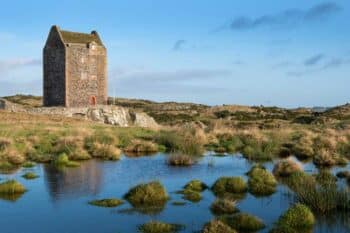
Today, apart from an earthen bank and ditch defences, there are few visible reminders of old Roxburgh. It is quite possibly the only completely deserted medieval town in Europe.
Of Roxburgh Castle, there are some scattered remains still visible which sadly do little to remind us of the authority it once had.
Despite the unwelcome attention of English armies and later Protestant reformers, parts of the nave, western transept and the Galilee porch at the west end still exist in Kelso Abbey.
They are enough to allow the many visitors who come to Kelso to appreciate the magnificent Romanesque architecture.
Related Content
Two years before the Earl of Hertford pitched his tent at Roxburgh, he stood at the door of the abbey vowing to, “rase and deface this house of Kelso so as the enemye shal have lytell commoditie of the same.”
At some point he had a change of heart and instead proposed that the, already damaged, site be fortified instead and plans were drawn up by Archangelo Arcano an Italian gunfounder in the service of Henry VIII.
Because the ground was too stony and the building was overlooked, the plan was later abandoned and Arcano’s drawings were lost.
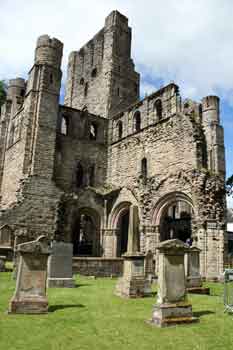
However, their subsequent reappearance many years later gave scholars an invaluable understanding of the state of the abbey at that point in time.
In addition there was as a glimpse of what ‘might have been, if conditions had been right.
The story of the king’s death at Roxburgh in 1460 introduces another Borders castle into the story.
It was Hume Castle, a mere six miles from Kelso was used by James as his base during his siege of Roxburgh Castle.
Over the years the castle, which changed hands numerous times, played its part in many of the events that shaped Scotland.
It was Colonel George Fenwick, an officer in Cromwell’s army, who administered the final coup de grâce.
Following Oliver Cromwell’s victory at the Battle of Dunbar in 1650, Fenwick, under orders from Cromwell to destroy all border castles, arrived in February 1651 at the approaches to Hume Castle.
Despite the strength of the walls Fenwick’s cannon soon destroyed much of the building forcing the garrison to surrender.
In 1789, the 3rd Earl of Marchmont decided to enclose the ruins with a new wall. Some critics called it distinctive while others, perhaps more accurately, described its exaggerated crenellations as a folly.
French Invasion
In the early 19th century as Britain held its breath and worried about a French invasion, warning beacons were placed on high points throughout the country ready to be ignited at the sign of trouble.
On 31 January 1804, Hume Castle’s duty sergeant, spotted what he thought was a warning fire and lit the castle’s own beacon.
In response local volunteers turned out, expecting to face the soldiers of Napoleon. In the end it was a false alarm and the incident became known as the ‘Great Alarm’.
Of course, relieved local residents would not have known that within a few years hundreds of Napoleonic prisoners of war would be housed in nearby Kelso and other Scottish Borders towns.
Scottish Reformation
From Kelso’s (Rennie) bridge, the inspiration for London’s Waterloo Bridge, which crosses the River Tweed there is a fine view of Floors Castle, easily the town’s most prominent building.
The castle, sited on a large estate and perhaps better described as a stately home, is the home of the Duke of Roxburghe.
Until the Scottish Reformation in 1560, the estate was held by Kelso Abbey. Following that, James VI awarded it to one of his favourites, Robert Ker of Cessford, later the Earl of Roxburghe.
The family continued as a powerful force in Scotland and it was the 5th Earl who helped assure the success of the Union negations of 1707. In recognition, he became the first Duke of Roxburghe.
To reflect his elevated status, work, to designs by William Adam, began on a new home at Floors turning an old tower house into a splendid Georgian mansion.
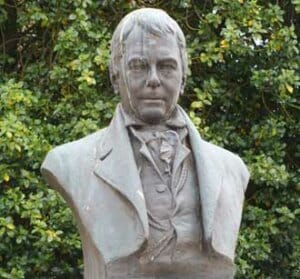
Floors was further developed during the early 19th century, by the 6th Duke and the celebrated architect William Henry Playfair.
Today Historic Environment Scotland describes the building as a “Quasi-Caroline Castle.”
As a young man, Sir Walter Scott got to know Kelso well, inheriting property from his uncle.
He spent many long summers with his aunt in a house facing the abbey.
Kelso history tells us that it was in his eyes, “the most beautiful, if not the most romantic town in Scotland.”
Perhaps better known is Scott’s association with Smailholm Tower which lies only six miles west of Kelso and has a special place in Kelso’s history.
It is an impressive structure, sixty-five feet tall with walls up to nine feet thick; it was originally built for the Pringle family, squires of the earls of the Black Douglas during the first half of the 15th century.
Despite its obvious strength, it didn’t always protect the family against the fearsome Border Reivers, who raided and plundered on both sides of the Scotland-England border.
As a young boy, Scott was sent to Smailholm, which by this time was owned by his family, to recover from illness.
It was here that he learned from his grandmother about the region’s rich history, culture and traditions, crucial elements in his later development as a poet and writer.
Napoleonic prisoners of war
One February evening in 1813, at his home at Abbotsford, Scott played host to Adelbert Doisy and a small number of other French military men.
They were part of a much larger group of Napoleonic prisoners of war housed in Kelso and throughout the Scottish Borders.
As officers, unlike the common soldiers who were imprisoned in dreadful conditions, they ‘lodged’ with local people and were free to move within the town boundaries.
They were paid half a guinea a day by the British government and many also had private means.
Duke and Duchess of Roxburghe
In order to pass the long tedious hours, they spent considerable sums of their own money to create activities that would help them to pass the time.
Cookery lessons, musical recitals and in Kelso a derelict store was turned into a theatre, where for special performances the Duke and Duchess of Roxburghe would attend.
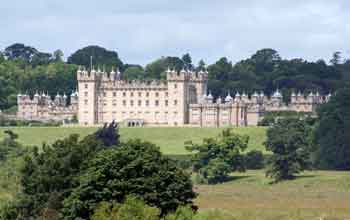
On one occasion the Kelso Mail ran an advert placed by Mr Brement, Professor of Belles Lettres and French prisoner of war.
It announced that i, “respectfully informs the ladies and gentlemen of Kelso that he teaches the French and Latin languages.”
When they were finally repatriated one Kelso resident noted that the prisoner’s stay, “was the gayest that Kelso had since the tragedy of Flodden cast its pall across the country.”
In his book, which appeared many years later, Doisy angrily accused Scott, who had since published his nine-volume Life of Napoleone, “of distorting each incident told by us with malevolent insinuations…”
Nobel Prize in Physiology or Medicine
In 1943, Edward Adelbert Doisy an American biochemist and distant relative of the man who dined with Walter Scott shared the Nobel Prize in Physiology or Medicine.
In 2004, hoping to reveal some of Roxburgh’s long-hidden secrets Channel Four television’s Time Team carried out a small-scale archaeological investigation.
Using aerial photography, geophysics and more traditional methods to explore the site, a miscellany of objects was unearthed.
Among other successes, the archaeologists were able to establish the general outline of Roxburgh and the line of the two main streets, King Street, which may have been the Senedgate recorded in 1290, and Market Street first noted in 1345.
Using existing sources they were even able to name possible tenants of some of the houses which would have lined the streets.
Had Cosmo Innes who, all these years ago, confidently argued that of Roxburgh, “not a house, not a trace remains” still been with us today he surely would have celebrated the results.
- For more information about Kelso, please see the Visit Scotland official website.